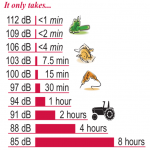Speaking of Social Isolation: Hearing Loss
By Ellen S. Gibson
Have you ever listened to a conversation being spoken in a foreign language?
I know some French but I’m not fluent, and it takes a lot of concentration for me to listen to people speaking in French. If my mind wanders, I’m lost. It’s the same for people who can’t hear well. They have to work really hard to remain part of the conversation. Trying to understand takes a lot of effort. It’s easy to be left behind.
Being left out of daily family conversations is socially isolating. It can be devastating. Humans are a social species. We need to connect to thrive. We need to communicate to connect.
Statistics vary but the consensus is that hearing loss is way too common across all age groups, especially for those over 70 years old. Likely you know someone who is hard of hearing. Why is hearing loss so common? What can we do about it? Author David Owen asks these questions in his book Volume Control: Hearing in a Deafening World1. The book is a fascinating journey through the science of sound, how we hear, and what can go wrong.
The complexity of the hearing mechanism
Owen writes that within our inner ear there is a complex system of tiny bones, fluid-filled channels, and hairs that send vibrations to the brain to be translated as sound. The system is completely set up and functioning at birth. It is able to detect sounds that are very, very soft, and very, very loud.
When our hearing is undamaged, the range of sounds we hear is so great that a logarithmic decibel scale was devised to measure it. The softest sounds we can hear are zero decibels (dB). Whispers are 30 dB. A normal conversation is 50 dB. A tractor engine is 90 dB, a squealing pig is 135 dB.
90 dB is one billion times the sound intensity of a sound at 0 dB. To hear such an amazing range of sounds is a biological miracle.
How is hearing damaged?
The environment has become increasingly noisy, mainly due to human activity—from the clanging of the first rough tools against stone, cannons blasting, warfare, steam engines, electronic music, tractors, lawnmowers, sirens, motorcycles, chainsaws. Owens writes that throughout our lives, we are constantly bombarded with louder and louder sounds that damage the delicate hairs that transmit sound along the nerves to our brain. Once they are damaged, they can’t be fixed.

This chart shows how damage hazard is related to the loudness of sound and length of exposure. The red bar shows how long it takes for a specific sound level to become dangerous. One single, momentary exposure to a very loud noise, like a gun being fired at close range (135-185 dB), will cause permanent damage.
Protect your hearing
Hearing protection is recommended to protect against sounds above 85 dB. This includes most of the common equipment around the farm: tractor, electric drill, chainsaw, or a lawnmower are examples. To protect your hearing from the damage of long hours spent on a tractor, you can:
- wear ear muffs
- wear correctly inserted earplugs
- sit in an enclosed cab
- take precautions to reduce the sound vibration
Hear for life
It is never too late to start protecting your hearing. Some hearing is lost as a natural result of aging, but 95% of hearing loss is preventable. Use hearing protection to reduce excessive noise exposure even if you already have experienced hearing loss. You can’t regain what you have lost, but you can protect your ears from further damage. A pair of earmuffs, used consistently, is good insurance when the costs of losing your hearing are so high.
Coming soon: I will look at current trends in assistive technology for the hearing impaired. Join the conversation. Are you hard of hearing? Do you have experience with devices to help you hear better? Please send in any insights you have to: gellen2010@gmail.com. Thank you!
For more information on hearing loss:
- Visit the Maine AgrAbility webpage.
- https://extension.psu.edu/noise-induced-hearing-loss-in-agriculture
- “It’s Loud Out There: Hearing Loss across the Lifespan,” a program of the Centers for Disease Control, https://www.cdc.gov/grand-rounds/pp/2017/20170620-hearing-health.html
- http://dangerousdecibels.org/ is an educational website on noise-related hearing loss in children, teens, and adults. There are classroom materials to share with school children.
- How to insert earplugs: https://www.3m.com/3M/en_US/worker-health-safety-us/personal-protective-equipment/no-roll-ear-plugs/
1 Owens, David, 2019, Volume Control: Hearing in a Deafening World. Riverside Books, New York.
